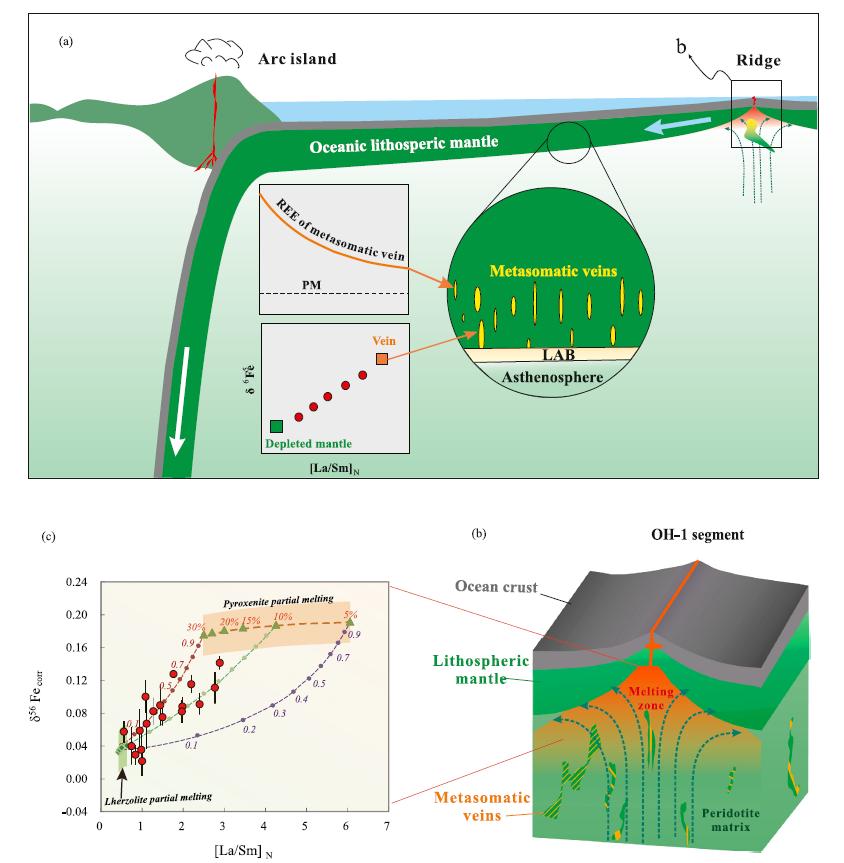Study Reveals Low-degree Melt Metasomatic Origin of Heavy Fe Isotope Enrichment in MORB Mantle
Studies of mid-ocean ridge basalts (MORB) show a variable Fe isotope composition of the oceanic upper mantle, beyond explanation by processes of mantle melting from a uniform source and magma evolution, indicating Fe isotope heterogeneity in the oceanic upper mantle. However, the origin of upper mantle Fe isotope heterogeneity remains enigmatic.
Recently, in order to verify the hypothesis that MORB mantle heavy Fe isotope (56, 57Fe vs. light 54Fe) enrichment results from the same process of incompatible element enrichment associated with low-degree melt mantle metasomatism in Earth's history, Dr. GUO Pengyuan from the Institute of Oceanology of the Chinese Academy of Sciences (IOCAS) and co-authors conducted an Fe isotope study of well-characterized MORB samples from a magmatically robust segment (OH-1) of the Mid-Atlantic Ridge (MAR) at ~ 35°N.
The study was published in Nature Index journal Earth and Planetary Science Letters on Nov. 9.
The studied 18 samples show large δ56Fe variation (+0.03 to +0.18 ‰ with an average of +0.10 ± 0.08 ‰, 2SD), reflecting a rather large MORB Fe isotope variability on such a ridge segment scale. What is striking is the statistically significant correlations (R2 ≥ 0.42; N = 15) of δ56Fecorr with the abundances (e.g., K2O, Ba, La) and ratios of more-to-less incompatible elements (e.g., [La/Sm]N, K2O/TiO2, Zr/Y), and even with Sr-Nd-Hf isotopes. The large δ56Fe variation and the significant correlations with the abundances and ratios of incompatible elements and with radiogenic isotopes of the OH-1 lavas are not caused by seawater alteration, partial melting, magma evolution and mixing in the magma chamber, but reflect a clear mantle source inheritance beneath this part of the MAR.
Because low-degree melting can effectively fractionate elements of varying incompatibilities, especially between elements with small or subtle incompatibility difference, the correlated Fe isotope variation (δ56Fe = +0.03 to +0.18 ‰) with the abundances and ratios of incompatible elements indicates a common process that leads to enrichment of heavy Fe and incompatible elements. "We explain this process as low-F melt mantle metasomatism taking place at the oceanic LAB in earth's history, and possibly preserved in the pyroxenite veins/veinlets dispersed in the peridotite matrix," said Dr. GUO. Melting of such recycled composite lithologies beneath the present-day sub-ridge produces MORB melts with geochemical correlations as observed at ridge segment OH-1 of the MAR. The positive correlation of δ56Fe with 87Sr/86Sr and negative correlations with 143Nd/144Nd and 176Hf/177Hf further indicate an ancient formation of the low-F melt metasomatic mantle.
"We suggest that low-F melt mantle metasomatism causing upper mantle heavy Fe isotope enrichment is a globally common process and widespread, because the available global MORB Fe isotopes show systematic correlations with the abundances and ratios of their incompatible elements," added Dr. GUO.
This work was supported by the National Natural Science Foundation of China, etc.

Fig. 1 (a) Global distribution of MORB (green circles) and OIB (orange stars) samples with Fe isotope data available; (b) Portion of the bathymetric map of the North Atlantic; (c) Detailed bathymetric map showing the Mid-Atlantic Ridge and the sampling sites in this study.

Fig. 2 Schematic illustrations on the origin of the Fe isotope systematics of the OH-1 MORB.
Guo, P., Niu, Y., Chen, S., Duan, M., Sun, P., Chen, Y., Gong, H., Wang, X., 2023. Low-degree melt metasomatic origin of heavy Fe isotope enrichment in the MORB mantle. Earth Planet. Sci. Lett. 601, 117892.
(Text by GUO Pengyuan)
Media Contact:
ZHANG Yiyi
Institute of Oceanology
E-mail: zhangyiyi@qdio.ac.cn
(Editor: ZHANG Yiyi)